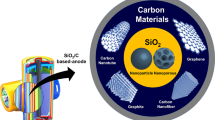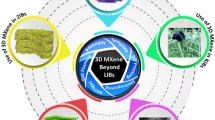Abstract
High-performance transition metal selenides are considered as promising electrode materials in alkali-ion batteries. However, the poor conductivity limits their further application. Herein, FeSe2 nanoparticles anchored on reduced graphene oxide (FeSe2@rGO) hybrid composites are prepared by a simple hydrothermal method and designed as promising anodes for lithium/sodium-ion batteries. The as-prepared FeSe2@rGO hybrids exhibit superior electrochemical performance with large reversible capacity and excellent cycling stability. In particular, the FeSe2@rGO electrodes deliver a specific capacity of 945.8 mAh g−1 for LIBs and a reversible capacity of 468.8 mAh g−1 for SIBs after 100 cycles at a current density of 100 mA g−1. Besides, the FeSe2@rGO electrodes demonstrate impressed rate capability and high ion diffusion coefficient. The results could enrich electrode materials synthesis methodologies and understand the complex charge–discharge process of metal selenides for next-generation batteries.







Similar content being viewed by others
References
Larcher D, Tarascon JM (2015) Towards greener and more sustainable batteries for electrical energy storage. Nat Chem 7:19–29
Scrosati B, Garche J (2010) Lithium batteries: status, prospects and future. J Power Sources 195:2419–2430
Zhamu A, Chen GR, Liu CG, Neff D, Fang Q, Yu ZN, Xiong W, Wang YB, Wang XQ, Jang BZ (2012) Reviving rechargeable lithium metal batteries: enabling next-generation high-energy and high-power cells. Energy Environ Sci 5:5701–5707
Gao MR, Xu YF, Jiang J, Yu SH (2013) Nanostructured metal chalcogenides: synthesis, modification, and applications in energy conversion and storage devices. Chem Soc Rev 42:2986–3017
Kundu D, Talaie E, Duffort V, Nazar LF (2015) The emerging chemistry of sodium ion batteries for electrochemical energy storage. Angew Chem Int Ed 54:3431–3448
Yabuuchi N, Kubota K, Dahbi M, Komaba S (2014) Research development on sodium-ion batteries. Chem Rev 114:11636–11682
Kim SW, Seo DH, Ma X, Ceder G, Kang K (2012) Electrode materials for rechargeable sodium-ion batteries: potential alternatives to current lithium-ion batteries. Adv Energy Mater 2:710–721
Palomares V, Serras P, Villaluenga I, Hueso KB, Carreterogonzález J, Rojo T (2012) Na-ion batteries, recent advances and present challenges to become low cost energy storage systems. Energy Environ Sci 5:5884–5901
Wen Y, He K, Zhu YJ, Han FD, Xu YH, Matsuda I, Ishii Y, Cumings J, Wang CS (2014) Expanded graphite as superior anode for sodium-ion batteries. Nat Commun 5:4033
Smith AJ, Burns JC, Zhao XM, Xiong DJ, Dahn JR (2011) A high precision coulometry study of the SEI growth in Li/graphite cells. J Electrochem Soc 158:A447–A452
Kang E, Jung YS, Cavanagh AS, Kim GH, George SM, Dillon AC, Jin KK, Lee J (2011) Fe3O4 Nanoparticles confined in mesocellular carbon foam for high performance anode materials for lithium-ion batteries. Adv Funct Mater 21:2430–2438
Yan LT, Chen G, Sarker S, Richins S, Wang HQ, Xu WC, Rui XH, Luo HM (2016) Ultrafine Nb2O5 nanocrystal coating on reduced graphene oxide as anode material for high performance sodium ion battery. ACS Appl Mater Interface 8:22213–22219
Xia L, Wang SQ, Liu GX, Ding LX, Li DD, Wang HH, Qiao SZ (2016) Flexible SnO2/N-doped carbon nanofiber films as integrated electrodes for lithium-ion batteries with superior rate capacity and long cycle life. Small 12:853–859
Xu XJ, Liu J, Liu JW, Ouyang LZ, Hu RZ, Wang H, Yang LC, Zhu M (2018) A general metal-organic framework (MOF)-derived selenidation strategy for in situ carbon-encapsulated metal selenides as high-rate anodes for Na-ion batteries. Adv Funct Mater 28:1707573
Li JB, Yan D, Lu T, Yao YF, Pan LK (2017) An advanced CoSe embedded within porous carbon polyhedra hybrid for high performance lithium-ion and sodium-ion batteries. Chem Eng J 325:14–24
Xiang T, Tao S, Xu WY, Fang Q, Wu CQ, Liu DB, Zhou Y, Khalil A, Muhammad Z, Chu WS, Wang ZH, Xiang HF, Liu Q, Song L (2017) Stable 1T-MoSe2 and carbon nanotube hybridized flexible film: binder-free and high-performance Li-ion anode. ACS Nano 11:6483–6491
Wang H, Lan XZ, Jiang DL, Zhang Y, Zhong HH, Zhang ZP, Jiang Y (2015) Sodium storage and transport properties in pyrolysis synthesized MoSe2 nanoplates for high performance sodium-ion batteries. J Power Sources 283:187–194
Yue JL, Sun Q, Fu ZW (2013) Cu2Se with facile synthesis as a cathode material for rechargeable sodium batteries. Chem Commun 49:5868–5870
Han G, Chen ZG, Ye D, Yang L, Wang LZ, Drennan J, Zou J (2014) In-doped Bi2Se3 hierarchical nanostructures as anode materials for Li-ion batteries. J Mater Chem A 2:7109–7116
Li N, Zhang Y, Zhao HY, Liu ZQ, Zhang XY, Du YP (2016) Synthesis of high-quality alpha-MnSe nanostructures with superior lithium storage properties. Inorg Chem 55:2765–2770
Park GD, Cho JS, Lee JK, Kang YC (2016) Na-ion storage performances of FeSex and Fe2O3 hollow nanoparticles-decorated reduced graphene oxide balls prepared by nanoscale kirkendall diffusion process. Sci Rep 6:22432
Zhang K, Hu Z, Liu X, Tao ZL, Chen J (2015) FeSe2 microspheres as a high-performance anode material for Na-ion batteries. Adv Mater 27:3305–3309
Wei XJ, Tang CJ, An QY, Yan MY, Wang XP, Hu P, Cai XY, Mai LQ (2017) FeSe2 clusters with excellent cyclability and rate capability for sodium-ion batteries. Nano Res 10:3202–3211
Zhao FP, Shen SD, Cheng L, Ma L, Zhou JH, Ye HL, Han N, Wu TP, Li YG, Lu J (2017) Improved sodium-ion storage performance of ultrasmall iron selenide nanoparticles. Nano Lett 17:4137–4142
Kong FJ, Lv LZ, Wang J, Jiao GH, Tao S, Han ZD, Fang Y, Qian B, Jiang XF (2018) Graphite modified AlNbO4 with enhanced lithium-ion storage behaviors and its electrochemical mechanism. Mater Res Bull 97:405–410
Zhang ZA, Shi XD, Yang X (2016) Synthesis of core-shell NiSe/C nanospheres as anodes for lithium and sodium storage. Electrochim Acta 208:238–243
Zhang F, Xia C, Zhu JJ, Ahmed B, Liang HF, Velusamy DB, Schwingenschlögl U, Alshareef HN (2016) SnSe2 2D anodes for advanced sodium ion batteries. Adv Energy Mater 6:1601188
Park GD, Kim JH, Kang YC (2016) Large-scale production of spherical FeSe2-amorphous carbon composite powders as anode materials for sodium-ion batteries. Mater Charact 120:349–356
Cho JS, Lee JK, Kang YC (2016) Graphitic carbon-coated FeSe2 hollow nanosphere-decorated reduced graphene oxide hybrid nanofibers as an efficient anode material for sodium ion batteries. Sci Rep 6:23699
Fan HS, Yu H, Zhang YF, Guo J, Wang Z, Wang H, Zhao N, Zheng Y, Du CF, Dai ZF, Yan QY, Xu J (2018) 1D to 3D hierarchical iron selenide hollow nanocubes assembled from FeSe2@C core-shell nanorods for advanced sodium ion batteries. Energy Storage Mater 10:48–55
Hummers WS, Offeman RE (1958) Preparation of graphitic oxide. J Am Chem Soc 80:1339
Shi WD, Zhang X, Che GB, Fan WQ, Liu CB (2013) Controlled hydrothermal synthesis and magnetic properties of three-dimensional FeSe2 rod clusters and microspheres. Chem Eng J 215–216:508–516
Lu YH, Goodenough JB, Dathar GKP, Henkelman G, Wu J, Stevenson K (2011) Behavior of Li guest in KNb5O13 host with one-dimensional tunnels and multiple interstitial sites. Chem Mater 23:3210–3216
Li J, Jin ZG, Liu T, Wang J, Zheng XR, Lai JY (2014) Chemical synthesis of MSe2(M=Ni, Fe) particles by triethylene glycol solution process. CrystEngComm 16:6819–6822
Deng Z, Liu TT, Chen T, Jiang JX, Yang WL, Guo J, Zhao JQ, Wang HB, Gao LJ (2017) Enhanced electrochemical performances of Bi2O3/rGO nanocomposite via chemical bonding as anode materials for lithium ion batteries. ACS Appl Mater Interface 9:12469–12477
Taberna PL, Mitra S, Poizit P, Simon P, Tarascon JM (2006) High rate capabilities Fe3O4-based Cu nano-architectured electrodes for lithium-ion battery applications. Nat Mater 5:567–573
Adelhelm P, Hu YS, Antonietti Maier J, Smarsly BM (2009) Hollow Fe-containing carbon fibers with tubular tertiary structure: preparation and Li-storage properties. J Mater Chem 19:1616–1620
Li XW, Qiao L, Li D, Wang XH, Xie WH, He DY (2013) Three-dimensional network structured α-Fe2O3 made from a stainless steel plate as a high-performance electrode for lithium ion batteries. J Mater Chem A 1:6400–6406
Wang XY, Hao H, Liu JL, Huang T, Yu AS (2011) A novel method for preparation of macroposous lithium nickel manganese oxygen as cathode material for lithium ion batteries. Electrochim Acta 56:4065–4069
Acknowledgements
This work was supported by National Natural Science Foundation of China (Nos. 11374043, 11374223, 11705015), Natural Science Foundation of Jiangsu Educational Department (No. 15KJA430001), Foundation of Jiangsu science and Technology Department (No. BA2016041), Six-talent peak of Jiangsu Province (No. 2012-XCL-036), Science and Technology Development Plan Project in Suzhou (Nos. SYG201738, SYZ201710), and Scientific Research Foundation of University (Grant No. XZ1628).
Author information
Authors and Affiliations
Corresponding authors
Rights and permissions
About this article
Cite this article
Kong, F., Lv, L., Gu, Y. et al. Nano-sized FeSe2 anchored on reduced graphene oxide as a promising anode material for lithium-ion and sodium-ion batteries. J Mater Sci 54, 4225–4235 (2019). https://doi.org/10.1007/s10853-018-3143-1
Received:
Accepted:
Published:
Issue Date:
DOI: https://doi.org/10.1007/s10853-018-3143-1




